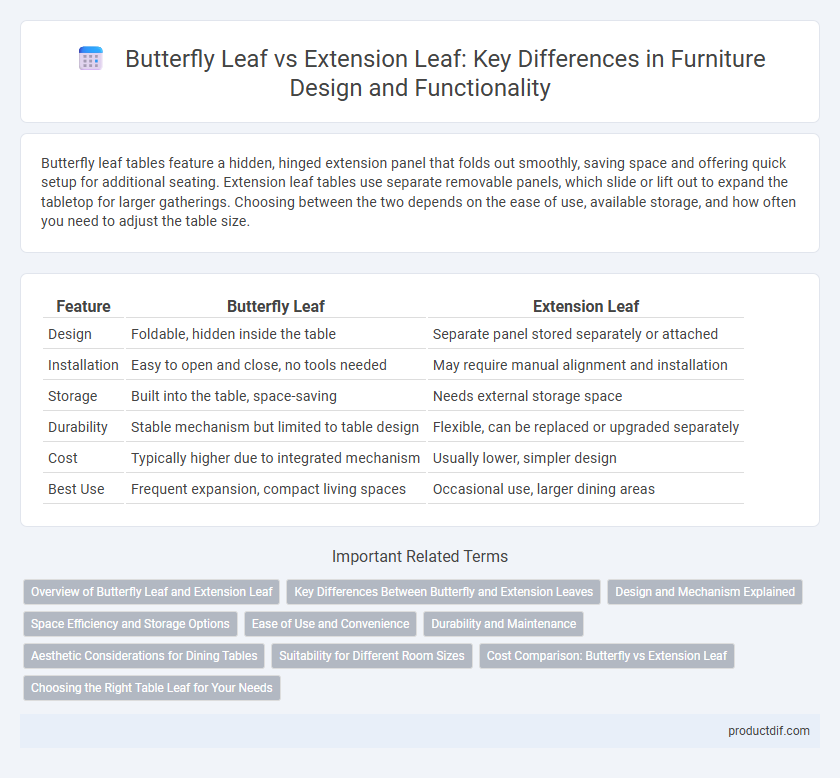Butterfly leaf tables feature a hidden, hinged extension panel that folds out smoothly, saving space and offering quick setup for additional seating. Extension leaf tables use separate removable panels, which slide or lift out to expand the tabletop for larger gatherings. Choosing between the two depends on the ease of use, available storage, and how often you need to adjust the table size.
Table of Comparison
| Feature | Butterfly Leaf | Extension Leaf |
|---|---|---|
| Design | Foldable, hidden inside the table | Separate panel stored separately or attached |
| Installation | Easy to open and close, no tools needed | May require manual alignment and installation |
| Storage | Built into the table, space-saving | Needs external storage space |
| Durability | Stable mechanism but limited to table design | Flexible, can be replaced or upgraded separately |
| Cost | Typically higher due to integrated mechanism | Usually lower, simpler design |
| Best Use | Frequent expansion, compact living spaces | Occasional use, larger dining areas |
Overview of Butterfly Leaf and Extension Leaf
Butterfly leaves feature a hinged design that folds in half underneath the table, allowing for easy storage and seamless expansion without extra space required during setup. Extension leaves typically slide out from under the table or are inserted separately, providing flexible length options but often needing additional storage space for removal. Butterfly leaves are ideal for compact areas due to their integrated mechanism, while extension leaves offer versatile sizing for larger gatherings.
Key Differences Between Butterfly and Extension Leaves
Butterfly leaves are hinged panels that fold out from the center of a table, providing quick and space-saving expansion, while extension leaves are separate panels inserted into the table, requiring removal and storage when not in use. Butterfly leaves often integrate seamlessly into the table's design, maintaining aesthetics and reducing the need for extra storage, whereas extension leaves usually demand additional storage space and manual handling. The choice between the two impacts ease of use, table stability, and overall functionality in dining furniture.
Design and Mechanism Explained
Butterfly leaves feature a hinged design that folds neatly under the table, providing a smooth, seamless extension without visible gaps. Extension leaves slide out horizontally from beneath the tabletop or insert into the center, often requiring additional support mechanisms such as slides or brackets. The butterfly leaf offers compact storage and easy operation, while extension leaves prioritize flexibility with varied placement options and structural reinforcement.
Space Efficiency and Storage Options
Butterfly leaves fold into a compact shape beneath the table, offering superior space efficiency and easy storage without extra furniture. Extension leaves require separate storage space, often needing dedicated cabinets or closets, which can limit room organization. Choosing butterfly leaves maximizes usability while minimizing storage footprint in small or multifunctional rooms.
Ease of Use and Convenience
Butterfly leaves offer seamless ease of use with a hinged design that folds neatly under the table, making extension quick and convenient without extra storage needs. Extension leaves, often requiring separate storage and manual placement, can be less convenient but provide greater flexibility in size options and table compatibility. Choosing between the two depends on prioritizing effortless setup versus customizable expansion.
Durability and Maintenance
Butterfly leaves offer moderate durability due to their foldable design, which can be prone to wear at the hinges but allows easy storage and minimal maintenance. Extension leaves, typically made from a single solid piece of wood or engineered material, provide superior durability and require less frequent maintenance, as they have fewer moving parts and a sturdier build. Regular cleaning and occasional tightening of screws enhance the longevity of either leaf type, but extension leaves generally offer better long-term resilience in furniture expansion.
Aesthetic Considerations for Dining Tables
Butterfly leaves offer a seamless aesthetic by folding neatly within the table, maintaining a streamlined and modern look when extended or stored. Extension leaves, often separate pieces stored elsewhere, can create slight gaps or changes in height, potentially disrupting the table's visual flow. Choosing between the two depends on balancing convenience with the desired continuity of the dining table's design and finish.
Suitability for Different Room Sizes
Butterfly leaves, folding neatly under one another, save space and suit smaller rooms by minimizing storage needs when not in use. Extension leaves require more storage space and are better suited for larger rooms where extra table length can be accommodated comfortably. Choosing between butterfly and extension leaves depends largely on room size constraints and the ease of expanding the table without disrupting the surrounding space.
Cost Comparison: Butterfly vs Extension Leaf
Butterfly leaves typically cost more due to their complex folding mechanism and integrated design, which requires precision engineering and higher-quality materials. Extension leaves, often simpler in construction, tend to be more affordable as they are separate panels that slide or insert into the table without intricate hardware. Choosing between the two depends on budget constraints and desired functionality, with butterfly leaves adding convenience and aesthetic value for a premium price.
Choosing the Right Table Leaf for Your Needs
Butterfly leaves offer seamless storage and quick deployment by folding within the table, ideal for those needing occasional extra space without sacrificing aesthetics. Extension leaves require separate storage and manual installation, best suited for larger gatherings or permanent size adjustments. Selecting the right table leaf depends on balancing convenience, storage space, and frequency of use to enhance furniture functionality.
Butterfly leaf vs Extension leaf Infographic

 productdif.com
productdif.com